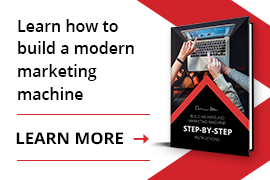
Dynamic retargeting or “remarketing” is the phenomenon by which your displayed ads serve as friendly reminders that your search history and purchases are being tracked. Past user behaviors dictate the types of ads that are shown in line with previous purchases and views.
So, you order your new pair of chucks online, when, lo and behold, your Facebook feed and AdWords banners are filled with ads for shoe laces, decals, skateboards, and energy drinks.
As uncomfortable as the initial realizations of mass surveillance may have sat with consumers, retargeting has become standard practice for ecommerce and web browsing in general. Users know that it’s happening; companies in the know employ it to their benefit. More importantly, retargeting is effective, with Google boasting clickthrough rates exceeding 450% for remarketing ads.
A Marriage of Ideas
Inbound marketing revolves around nurturing leads throughout the buying journey with targeted content. If you’re doing it right, your inbound content strategy already has tailored content for users at the awareness stage, the consideration stage, and the decision stage. Users at these different stages of the sales cycle have different questions and pain points that they are trying to address, and your content needs to reflect this.
Dynamic retargeting is a tool that complements this strategy by:
-
Salvaging bounces
-
Raising brand awareness and recall
-
Boosting repeat visitor rates
Watch Closely
In order to implement an effective retargeting strategy, you must understand your user behaviors at different stages of the buyer's journey. You define your own audience strategies through Facebook and Google Display Network (GDN) based on the user’s previous actions.
A user who made it to the pricing page of your website is likely further along in the buying process than one who skimmed one of your blogs. The way you reach out should adapt accordingly. Users already at the decision-making phase may be swayed by a repeat exposure to pricing, promotions, or deals. Users at the awareness stage are still figuring out their pain points and solutions and may need further exposure to the possibilities of implementing your service.
Implementing an effective retargeting strategy involves teasing out the differences in the different segments of your target market.
Adapt
If you can narrow down user behaviors that indicate their level of motivation and value to you as customers, you can adapt the resources that you’re willing to dedicate to capture their attention.
An identified SMB or consumer who’s in the buying cycle is more valuable to your marketing efforts and worth more for outbidding competitors. Luckily, both Facebook Ad Auctions and Google Adwords have systems in place to alternate your bidding price based on target market and combine that behavior with your retargeted ads.
Sorting Through Content
The way that you organize your content is huge. It makes the difference between a scattershot approach and precise execution with topic cluster models.One of the many benefits of keeping your content organized into topics and subcategories is that it allows you to determine specific user pain points based on traffic and target accordingly.
When conducting a retargeting campaign, it’s wise to take a look at user behaviors based on the topics they’re most interested in because it may not be every aspect of your content campaign that’s landing with your market segment.
Drawing Lines
With unlimited resources and all the time in the world, it might be tempting to reach out to potential buyers forever in the hopes of snagging a few strays. In the real world, however, optimizing your resources is always a point of consideration, and ad fatigue is part of that equation. Remarketing ads show slower rates of fatigue and higher rates of engagement than generic ads, but they do still grow old, which means that you need to determine how many times you reach out to potential leads.
A combination of an organized inbound marketing strategy with a remarketing campaign is a sure-fire way to implement an added level of precision. Like any other aspect of content marketing, numbers and careful consideration are your friend. Pay attention, be quick to adapt, and stay on the cutting edge.


